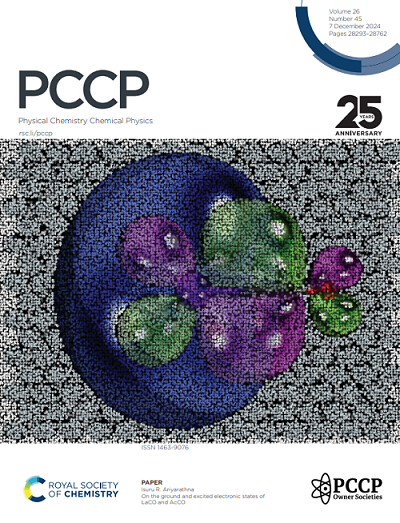Energy Decomposition Analysis for excited states: An Extension based on TDDFT
IF 2.9
3区 化学
Q3 CHEMISTRY, PHYSICAL
引用次数: 0
Abstract
To enhance the understanding of photochemical reactivity and its mechanisms, it is essential to analyze bonding interactions in excited-state reactions. Such insights can aid in optimizing these reactions. This paper presents an energy decomposition analysis method for excited states (exc-EDA), integrating the ground state EDA approach by Morokuma, Ziegler and Rauk with time-dependent density functional theory (TDDFT). The methodology focuses on calculating excitation energies, particularly for the intermediate states of the EDA. We introduce two variants: the first uses non-relaxed excitation coefficients (exc-u-EDA), where the excitation coefficients of the excited fragment are used directly; the second optimizes these coefficients for the intermediate states (exc-r-EDA). Exc-EDA can be applied with various density functionals, but the accuracy depends on the functional’s ability to describe the excited state properly. Smaller basis sets result in lower energy values due to fewer virtual orbitals, while larger basis sets produce consistent relative results but may involve different excited states in intermediate steps leading to artificial increase of energy terms in the EDA. The method’s convergence behavior resembles that of TDDFT, with a computational cost approximately three times that of the underlying TDDFT calculation. Application of exc-EDA to singlet fission in pentacene clusters demonstrates its practical value, offering quantitative insights into excited-state bonding and revealing clear, intuitive trends.为了加深对光化学反应性及其机理的了解,分析激发态反应中的键合相互作用至关重要。这些见解有助于优化这些反应。本文介绍了一种激发态能量分解分析方法(exc-EDA),将 Morokuma、Ziegler 和 Rauk 的基态 EDA 方法与时变密度泛函理论(TDDFT)相结合。该方法侧重于计算激发能量,特别是 EDA 中间状态的激发能量。我们介绍了两种变体:第一种使用非松弛激发系数(exc-u-EDA),即直接使用激发片段的激发系数;第二种针对中间状态优化这些系数(exc-r-EDA)。Exc-EDA可应用于各种密度函数,但精确度取决于函数正确描述激发态的能力。较小的基集会因较少的虚拟轨道而导致较低的能量值,而较大的基集则会产生一致的相对结果,但可能会在中间步骤中涉及不同的激发态,从而导致 EDA 中能量项的人为增加。该方法的收敛行为类似于 TDDFT,计算成本约为基础 TDDFT 计算的三倍。将 exc-EDA 应用于并五苯簇中的单子裂变证明了它的实用价值,为激发态成键提供了定量见解,并揭示了清晰、直观的趋势。
本文章由计算机程序翻译,如有差异,请以英文原文为准。
求助全文
约1分钟内获得全文
求助全文
来源期刊

Physical Chemistry Chemical Physics
化学-物理:原子、分子和化学物理
CiteScore
5.50
自引率
9.10%
发文量
2675
审稿时长
2.0 months
期刊介绍:
Physical Chemistry Chemical Physics (PCCP) is an international journal co-owned by 19 physical chemistry and physics societies from around the world. This journal publishes original, cutting-edge research in physical chemistry, chemical physics and biophysical chemistry. To be suitable for publication in PCCP, articles must include significant innovation and/or insight into physical chemistry; this is the most important criterion that reviewers and Editors will judge against when evaluating submissions.
The journal has a broad scope and welcomes contributions spanning experiment, theory, computation and data science. Topical coverage includes spectroscopy, dynamics, kinetics, statistical mechanics, thermodynamics, electrochemistry, catalysis, surface science, quantum mechanics, quantum computing and machine learning. Interdisciplinary research areas such as polymers and soft matter, materials, nanoscience, energy, surfaces/interfaces, and biophysical chemistry are welcomed if they demonstrate significant innovation and/or insight into physical chemistry. Joined experimental/theoretical studies are particularly appreciated when complementary and based on up-to-date approaches.
 求助内容:
求助内容: 应助结果提醒方式:
应助结果提醒方式:


